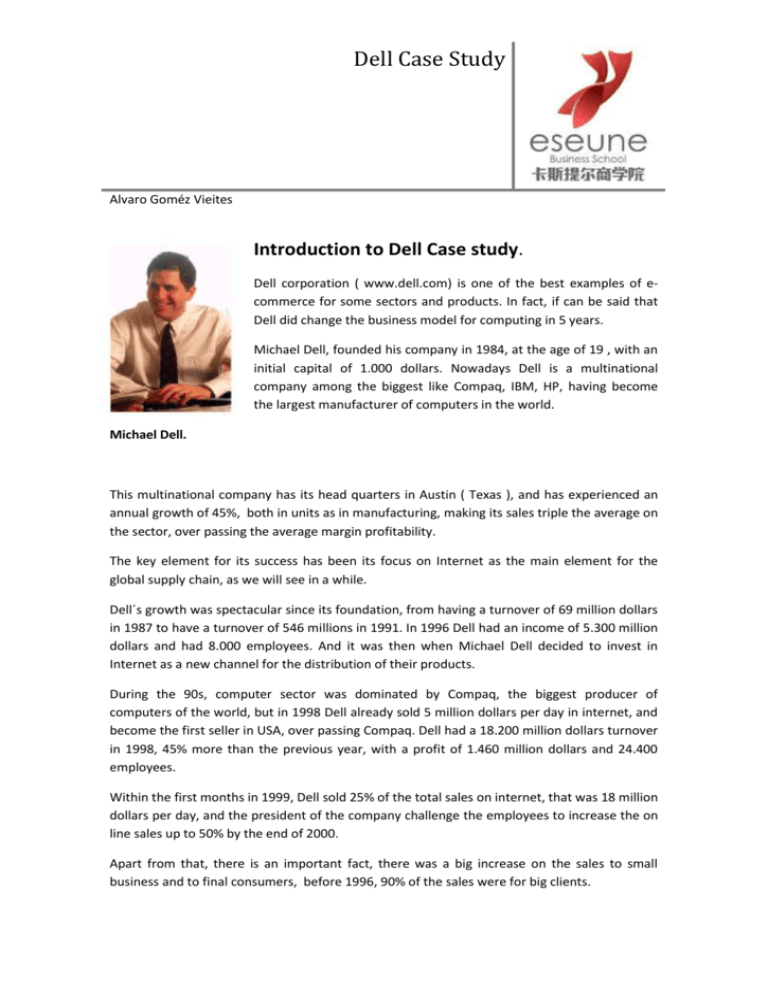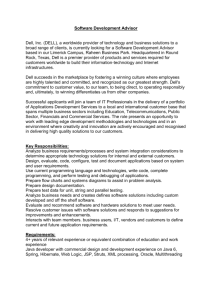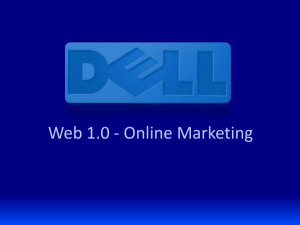Dell Case Study
advertisement

Dell Case Study Alvaro Goméz Vieites Introduction to Dell Case study. Dell corporation ( www.dell.com) is one of the best examples of ecommerce for some sectors and products. In fact, if can be said that Dell did change the business model for computing in 5 years. Michael Dell, founded his company in 1984, at the age of 19 , with an initial capital of 1.000 dollars. Nowadays Dell is a multinational company among the biggest like Compaq, IBM, HP, having become the largest manufacturer of computers in the world. Michael Dell. This multinational company has its head quarters in Austin ( Texas ), and has experienced an annual growth of 45%, both in units as in manufacturing, making its sales triple the average on the sector, over passing the average margin profitability. The key element for its success has been its focus on Internet as the main element for the global supply chain, as we will see in a while. Dell´s growth was spectacular since its foundation, from having a turnover of 69 million dollars in 1987 to have a turnover of 546 millions in 1991. In 1996 Dell had an income of 5.300 million dollars and had 8.000 employees. And it was then when Michael Dell decided to invest in Internet as a new channel for the distribution of their products. During the 90s, computer sector was dominated by Compaq, the biggest producer of computers of the world, but in 1998 Dell already sold 5 million dollars per day in internet, and become the first seller in USA, over passing Compaq. Dell had a 18.200 million dollars turnover in 1998, 45% more than the previous year, with a profit of 1.460 million dollars and 24.400 employees. Within the first months in 1999, Dell sold 25% of the total sales on internet, that was 18 million dollars per day, and the president of the company challenge the employees to increase the on line sales up to 50% by the end of 2000. Apart from that, there is an important fact, there was a big increase on the sales to small business and to final consumers, before 1996, 90% of the sales were for big clients. Dell Case Study Alvaro Goméz Vieites As a result, in year 1998, Compaq decided to follow same strategy model as Dell, and started selling by Internet and by phone, promoting Prosignia computers. But on February 1999, its distributors channel force the company to stop doing so, creating a big trouble within the distribution structure and strategy. Since then, business at Compaq has been experiencing troubles. At the end of 1999, bad business results, forced the CEO of the Compaq company to resign, Eckhard Pfeiffer, was able to make Compaq company the leader of personal computers, but failed to get the right strategy for the company get adapted to the new technologies of information in Internet, and the upcoming of a new era of cheaper personnel computers into the market. HP also tried to find its strategy in internet, and in 1999, a new division was created in order to start e-business. That same year in June, they launched an on line shop for sailing personal computers , servers, printers,.... to SME in Spanish market. (www.comprar.hp.es) Year 1999 Compaq was still the leader on personnel computers, selling 15.7 millions of PCs, with a share market of 14%, but Dell growth lead the company to the second position, selling 11,8 millions PCs, with a share market of 10,5%. On third position was IBM ( 9,1 millions PCs, 8,2 % share market), HP ( 7,5 millions PCs, and 6,7% share market) and NEC ( 5,9 million PCs, and 5,3 share market) Year 1999, Dell turnover was 30 million dollars per day on Internet, almost 50% of their total sales, almost 27% more than the previous year. During year 2000, its on line sales were 40 million dollars, more than 50% of their sales. Finally year 2001, Dell over passed Compaq, becoming first seller of personal computers. That year personal computers overcome a crisis, and Dell got the opportunity to increase its share market, willing to reach 40% of the market share. In fact many experts understood the fusion between HP and Compaq announced in September 2001, as an strategy in order to be able to compete with Dell. Same month IBM announced to close down their retail chain for PCs Activa, in order to sell those PCs only at Internet, a similar strategy as that of Dell. IBM lost 1.000 million dollars in 2000 on sales of PCs. Dell Case Study Alvaro Goméz Vieites Dell users are specialist who know the characteristics they are looking for when buying a PC, therefore they do not need to be advised by the retail shop assistance. But that was not the case for IBM, therefore implementing such an strategy of sales on Internet was not that easy, they invested 20 million dollars on direct marketing activities to launch the campaign ( Mailing and television ). Key factors for success in Dell case. In this section we will talk about what were on our opinion the key factors for Dell success. Let's start by studding global supply chain, as it was on the pcs sector. Providers of pcs Manufacturer, components assembler Distributors Retailers Clients In this kind of traditional market approach, companies are following a Push strategy, with mass production, following the expectancy of a future demand already calculated. Under this paradigm, standardized products are offered to clients who can have not a personalized product. Manufacturer hands the products to the whole retailers who send the products to the retail shop ( retail shop for PCs, or Malls ). It is the business model of the XX century under the umbrella of industrial revolution developed by Ford and Taylor in USA at the beginning of the XX century. If the client need a personalized PC, they must buy the standard model, and then incorporate by him or herself all the components and upgrades. Also pherifericals, like printers, are not integrated therefore users have to be in charge of installing those items, something that for many users is not so easy. This strategy creates plenty of stocks, at manufacturing premises, at whole retailers premises, at shops, etc and therefore an extra cost of money and time. Also PCs are technologic products, so there is the risk that new products with new technologies come into the market before the PCs on those stocks have been sold out. Following this business model, a mistake on the number of units to be manufactured or a bad prediction of future demand, can be a great problem for the company, both due to an overstock, or to a lack of stock. Dell Case Study Alvaro Goméz Vieites Also, under this business model, the manufacturer has not direct feedback from the final users. Clients are in direct communication with the retailers, who know the client's needs, and the products that best suits those clients. Manufacturer only gets to know the final users by complementing the registration of the equipment that is only done on some cases, because of lack of time or clients interest. Let's see now what is the business model of Dell. Providers of Manufacturer components assembler Logistic company Clients In this case, the strategy is that of pulling , that is clients demands the products to the produced, clients make small orders directly to the factory. The main advantages of this business model is that the company can offer the clients a personalized product, and has not stocks. This also allows the client to have always a product made out of the most updated components on the market. The slogan of Dell company was, we always offer fresh fish. With this business model, Dell clients feel themselves as part of the global supply chain. The client can select several items on the configuration of his/her PC, type of processor, memory, sound system, cd.rom, micro, modem, red card, etc, ..so those components are directly installed at the manufacturing process, so the client does not need to do it later on by himself. Also, the client can choose between other range of products like printers, scanners, etc. In June 1999 Dell make an agreement with HP in order to have HP printers at Dell premises in Limerick, Ireland. Dell can rotate its inventory almost each 6 days, that is 61 times per year, while other competitors like Compaq and IBM, do it each month. Dell buys components while manufacturing under an order, and get them stocked in lorries 15 meters away from the manufacturing line, optimizing the stock. Dell Case Study Alvaro Goméz Vieites Also, Dell offers its most important clients, an special personalized web site where they can buy with 15% cost saving. Dell strategy also has an impact on the financial area of the company, as most of the orders, are paid by bank transfer or credit card. Therefore the company already has the money 8 days before paying its own providers. This means Dell cash flow gets bigger at the same path than its sales, similar to the business models on big Malls. Also, Dell, have a post sale service to clients on Internet, that attends 70% of clients demands, keeping a good satisfaction on clients with a low cost infrastructure. Dell is the leader on clients satisfaction on the PCs business. This is actually quite impressing as it is the client that solves the problems by him/herself by getting connected to Dell website and following the instructions given , a service that before was undertook by Dell personnel. Same happens with the orders, it is the client that makes a detailed order indicating PC components , personal data, invoicing data, etc. All this online processes are making Dell save money while at the same time increasing clients satisfaction, as clients consider this, as a chance to get closer to the manufacturing process, also they have not timetables, and they do not need to wait for an answer. It is more convenient as they do not have to go to an store, etc... Dell strategy focus on direct sales to final clients, production of personalized PCs, reduction of stocks, and services by Internet. Dell has been able to offer a branch of high quality PCs, at a very good price, lower prices than its main competitors ( Compaq, IBM, HP ) In order to sell to clients with less technical knowledge, Dell is improving its catalog a lot, implementing automatic assistance for orders, also some chat and iP calls are being integrating into the order system so that Dell personnel can attend those clients that need Dell HRs assistance. Another key element for Dell success is that Dell knows its clients directly so the company know their clients needs, Dell knows which products clients visit, how often, what they buy and how, all this give Dell the chance to implement very efficient direct marketing activities by Internet. For example, Dell can send an email to a client that 2 years ago bought a PC with a printer, offering him some components for renewal. Dell Case Study Alvaro Goméz Vieites







